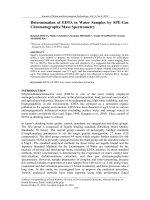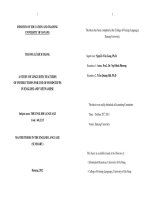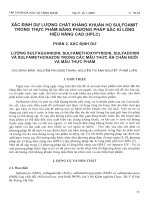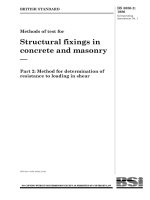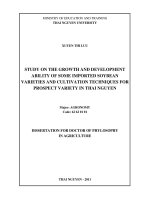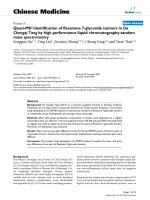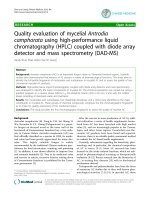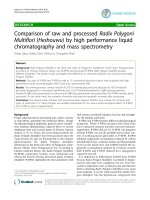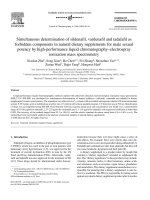Quantitative study for determination of astilbin in smilax glabra by high performance liquid chromatography
Bạn đang xem bản rút gọn của tài liệu. Xem và tải ngay bản đầy đủ của tài liệu tại đây (337.37 KB, 5 trang )
JOURNAL OF MILITARY PHARMACO-MEDICINE No7-2015
QUANTITATIVE STUDY FOR DETERMINATION OF ASTILBIN
IN SMILAX GLABRA BY HIGH PERFORMANCE LIQUID
CHROMATOGRAPHY
Le Viet Duc*; Vu Binh Duong**; Trinh Nam Trung**; Pham Thi Thanh Huong**
SUMMARY
Objectives: By using high performance liquid chromatography (HPLC), we develop and
validate an analytical method for astilbin. Methods: Development of chromatographic conditions
for astilbin quantification in Rhizoma Smilacis glabra. The method was validated according to
ICH guidelines. Results: We investigated HPLC chromatographic conditions, including
Phenomenex Gemini RP C18 column (4.6 mm x 250 mm, 5 µm) at a flow rate of 1.0 mL/min,
detection wavelength of 291 nm, and an isocratic elution of 0.1% aqueous acetic acid - acetonitrile
(70:30, v/v). The method displayed an acceptable precision (RSD ≤ 1.37%) and accuracy.
The detection and quantification limits were 0.5 μg/ml and 1.5 μg/ml respectively. Conclusion:
The HPLC analytical method of astilbin was validated to meet requirements of ICH guidelines.
* Key words: Smilax glabra; High performance liquid chromatography; Astilbin.
INTRODUCTION
Smilax glabra is a wild herb grown in the
northern mountainous provinces of Vietnam.
According to Vietnamese traditional medicine,
Smilax glabra is often used in treatment of
tendon diseases, worms, ulcers, diabetes,
and detoxification... [1]. Concerning to
compositions of Smilax glabra, astilbin, which
is the main active constituent (figure 1) with
high content, has been revealed to have
hypouricemic, anti-inflammatory, analgesic
anti-oxidation effects [2, 3]. Thus, quantitation
for studies on extraction as well as quality
control is very important.
Figure 1: The chemical structure
of astilbin.
Vietnam Military Medical University has
formulated several pharmaceutical products
that contains Smilax glabra, such as: “Thong
Phong Khang”, “Kien khop tieu thong”...
* Minishy of Defense
** Vietnam Military Medical University
Corresponding author: Vu Binh Duong ()
8
JOURNAL OF MILITARY PHARMACO-MEDICINE No7-2015
to serve public health care. In order to
standardize Smilax glabra as well as its
products, development and validation of
astilbin quantitative method is required.
In this study, we developed and validated
a quantitative analysis of astilbin in
Smilax glabra using high-performance
liquid chromatography (HPLC).
10 mL volumetric flask, filtered through
0.22 µm membrane before HPLC analysis.
* Chromatographic conditions:
There were several reports on HPLC
analysis of astilbin [5, 6]. In this study, we
selected chromatographic conditions to
develop an appropriate analytical method.
* Validation of analysis method:
MATERIALS AND METHODS
1. Materials and equipment.
Smilax glabra was obtained from Son
Lam Pharmaceutical Company complying
the forth Vietnamese Pharmacopoeia.
Astilbin standard was purchased from
Sigma Aldrich, 99.9%. HPLC grade methanol
(MeOH), acetonitrile (ACN), distilled water
were purchased from Merck. All reagents
used were of analytical grade (PA). High
performance liquid chromatography system
(Waters 1525 Binary HPLC pump; USA)
was applied in this study.
2. Methods.
* Sample preparation:
- Standard preparation: Powder of
standard astilbin is dissolved in MeOH to
make the stock solution of 1.000 µg/mL.
Dilute the stock solution to get working
standard solutions.
- Sample preparation: Accurately weighed
about 1.0 g of powdered Smilax glabra,
performed ultrasonic extraction using MeOH
solvent (8 ml x 3 times). The extracts were
centrifuged and poured into 200 mL
volumetric flask and diluted up to the mark
with methanol. Then diluted ten-folded using
Validation of analytical method was
carried out in accordance with the
guideline of ICH (International Conference
on Harmonisation) [4] for raw materials
and finished products with the following
criteria: system suitability, selectivity specificity; linearity; accuracy; precision;
limit of detection (LOD) and limit of
quantification (LOQ).
RESULTS
1. Chromatographic conditions.
Based on published researches [5, 6],
we developed chromatographic conditions
for astilbin analysis which consisted of
C18 column (4.6 x 250 mm, 5 μm) using a
mobile phase of 0.1 aqueous acetic acid ACN (70:30, v/v) at a flow rate of 1 mL/min.
UV - VIS detector was employed at 291 nm.
Injection volume of 10 µL was subjected
to HPLC system. For the proposed conditions,
the chromatograms on the figure 2 showed
well-resolved and symmetrical peaks of
astilbin with retention time of approximately
19.7 minutes, which is suitable for analyzing
astilbin in Smilax glabra. So, we choose
these conditions of chromatographic method
for validation.
9
JOURNAL OF MILITARY PHARMACO-MEDICINE No7-2015
2. Method validation.
* System suitability, specificity:
a
time (19.43 ± 1.77, RSD = 1.77) and peak
area (11,0192 ± 797, RSD = 1.77) were
not more than 2%. Therefore, the method
is comply to system suitability criteria.
Analyze the standard, blank and test
solutions of astilbin simultaneously. The
spectrum of the peak at retention time of
19.7 of standard and test solutions proved
that it was surely of astilbin (figure 3).
a
b
b
c
Figure 3: UV-Vis spectrum of peaks at
19.7 minute of standard solution (a)
and test solution (b).
Figure 2: Chromatogram of blank solution (a),
standard solution (b), test solution (c).
Six replicate injections of a working
standard solution of 5 µg/mL were
injected. Retention time and peak area
were evaluated. The results indicated that
relative standard derivations of retention
10
In figure 2, peak of astilbin was completely
separated from peaks of impurities,
symmetric and narrow width.
The retention time of astilbin in the
chromatogram of the test solution and
standard solution were the same. There
weren’t any corresponding peak in the
chromatogram of blank solution. Therefore,
the method showed high selectivity and
specificity.
JOURNAL OF MILITARY PHARMACO-MEDICINE No7-2015
* Linearity:
Peaks areas (µ AU.s)
The working standard solutions from 5 to 100 µg/mL was injected to HPLC system.
Results showed that in the test range, there was a linear regression between peak area
and the concentration of astilbin. The linear equation was y = 22172 - 15877, with
correlation coefficient R2 of 0.999 (figure 4).
Concentration
g/ml
Concentration (µg/mL)
Figure 4: Behavior of peak area vs.concentration of astilbin.
* LOD and LOQ:
LOD was determined to be 0.5 µg/mL and LOQ was 1.5 mg/mL.
* Precision:
The precision of the method was carried out at 3 concentrations: LQC, MQC and HQC.
The results showed that the relative standard deviations at the concentrations during
intra and interday were less than 2% (table 1). Thus, the accuracy of the method was
satisfactory to analyze astilbin.
Table 1: Intraday and interday precision of standard solutions.
PRECISION
Repeatability
Intermediate
precision
LQC (10 µg/ml)
MQC (50 µg/ml)
HQC (100 µg/ml)
X ± SD (µAU.s)
212607 ± 2183
1051348 ± 6891
2218232 ± 4823
RSD (%)
1.03
0.66
0.22
X ± SD (µAU.s)
211941 ± 3877
1051937 ± 12870
2231226 ± 15550
RSD (%)
1.37
0.88
0.92
11
JOURNAL OF MILITARY PHARMACO-MEDICINE No7-2015
* Accuracy:
The accuracy of the method is performed
by spiking of 16 mg, 20 mg and 24 mg to
1.0 g of powdered Smilax glabra. Extraction
and chromatography analysis are conducted
using the proposed procedure. The recovered
percentages of astilbin were compared
with the original and determined as accuracy.
The results indicated that the percentages
of recovery were found in the acceptance
criteria of 80 to 120% (table 2). Therefore,
the quantitative methods completely meet
the requirements of ICH guidelines.
Table 2: Accuracy of astilbin in herbal
samples.
SPIKED AMOUNT
Recovery ( X ± SD, %)
16 mg
20 mg
24 mg
98.3 ±
4.6
100.0 ±
2.30
102.5 ±
1.00
CONCLUSION
The HPLC method has been developed
to determine astilbin in Smilax glabra using
Phenomenex Genimi RP - C18 column,
mobile phase containing 0.1% acetic acid ACN (70:30, v/v), flow rate of 1 mL/min,
UV - VIS detector at a wavelength of 291 nm,
and the injection volume of 10 µl . The
validated quantitative method has high
precision (98.3 ± 4.6% to 102.5 ± 1.00%)
and accuracy (RSD ≤ 1.37%), the correlation
coefficient (R2) of 0,999. Thus, the proposed
12
method is suitable to quantify astilbin in
Smilax glabra as well as pharmaceutical
products containing this compound.
REFERENCES
1. Loi Do Tat. Vietnamese Medicinal Plants
and Herbs. Medical Publishing House. 2004,
pp.498-499.
2. Qing-Feng Zhang, Zhong-Rong Zhang,
Hon-Yeung Cheung. Antioxidant activity
of Rhizoma Smilacis Glabrae extracts and its
key constituent-astilbin. Food Chemistry.
st
2009, July, 1 , Vol 115, Issue 1, pp.297-303.
3. Wen-Ai Xu et al. Study on the correlation
between constituents detected in serum from
Rhizoma Smilacis Glabrae and the reduction
of uric acid levels in hyperuricemia. Journal of
Ethnopharmacology. 2013, Vol 150, Issue 2,
pp.747-754.
4. ICH. Validation of analytical procedures,
Text and Methodology. Q2R1. 2005.
5. Liang Chen, Ye Yin, Hongwei Yi, Qiang Xu,
Ting chen. Simultaneous quantification of five
major bioactive flavonoids in Rhizoma Smilacis
Glabrae by high-performance liquid chromatography.
Journal of Pharmaceutical and Biomedical
Analysis. 2007, 43, pp.1715-1720.
6. Qing-Feng Zhang, Yu-Xian Guo, Xinchen
Shangguan, Guodong Zheng and Wen-Jun
Wang. Identification and quantification of
polyphenols in Rhizoma Smilacis chinae by
HPLC/DAD/ESI-MS/MS. Journal of Liquid
Chromatogrhaphy & Related Technologies.
2013, 36, pp.2251-2260.
